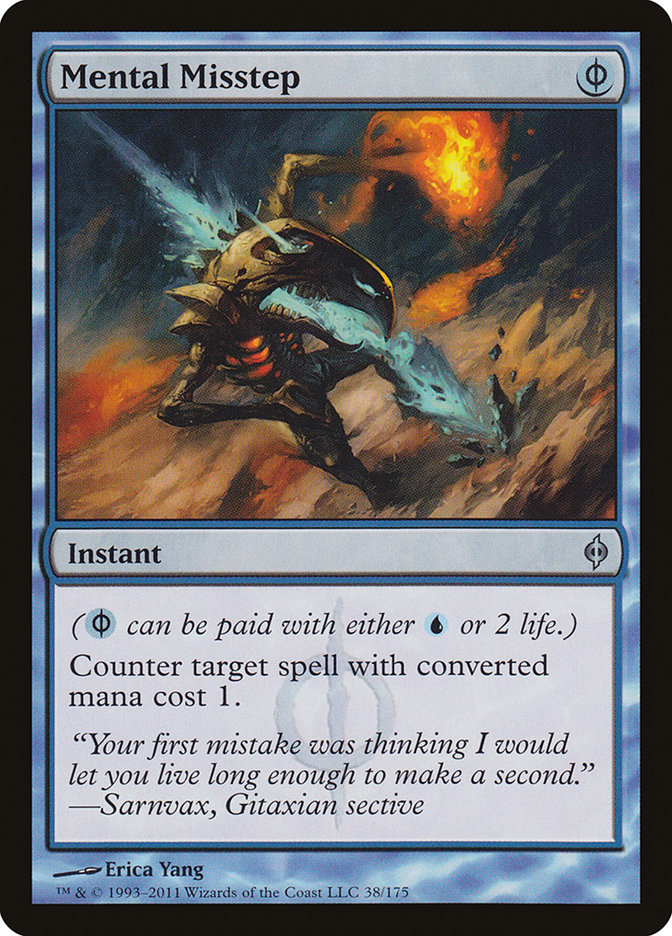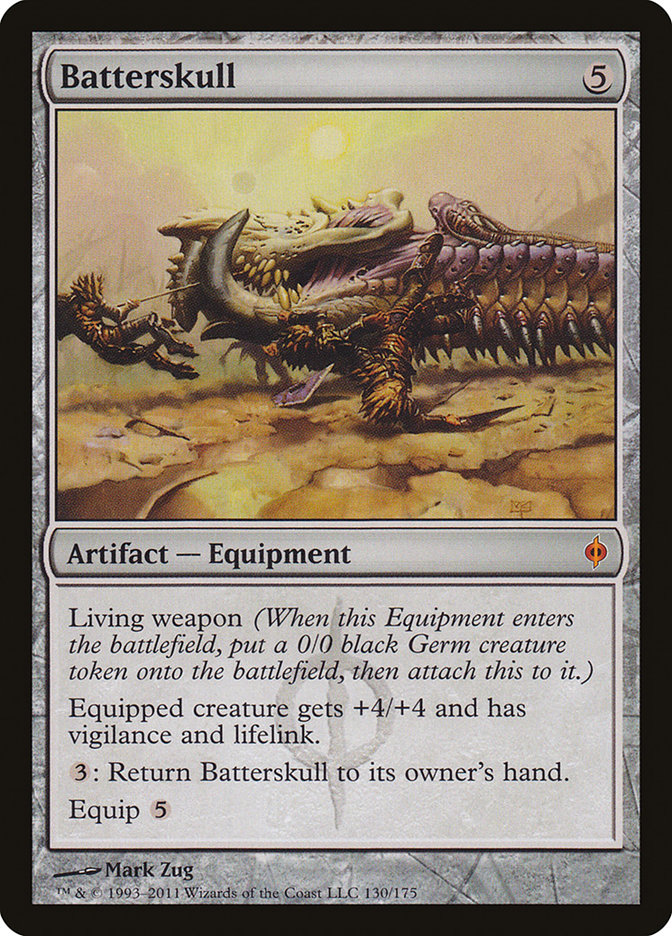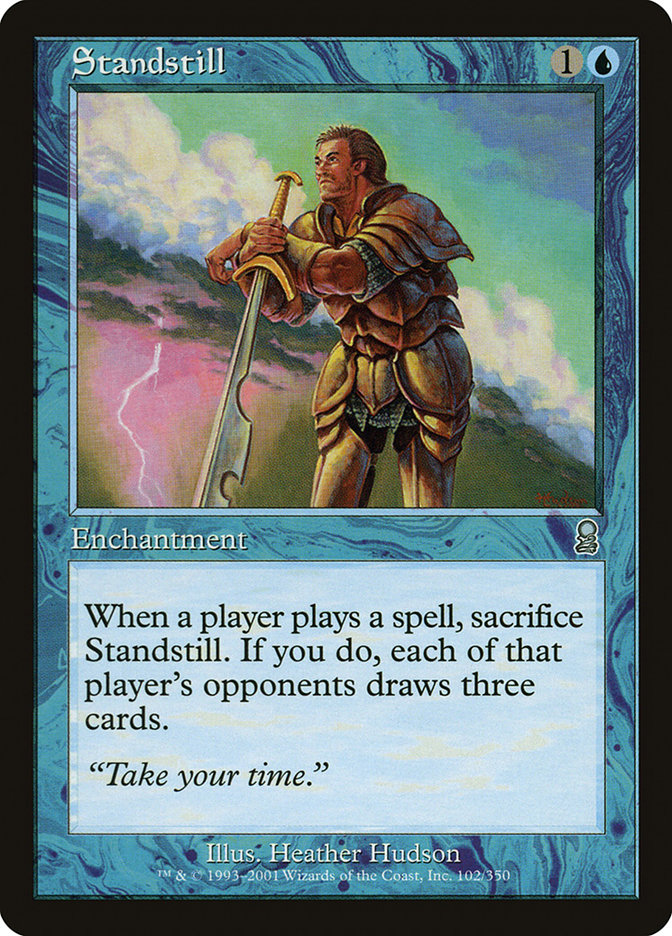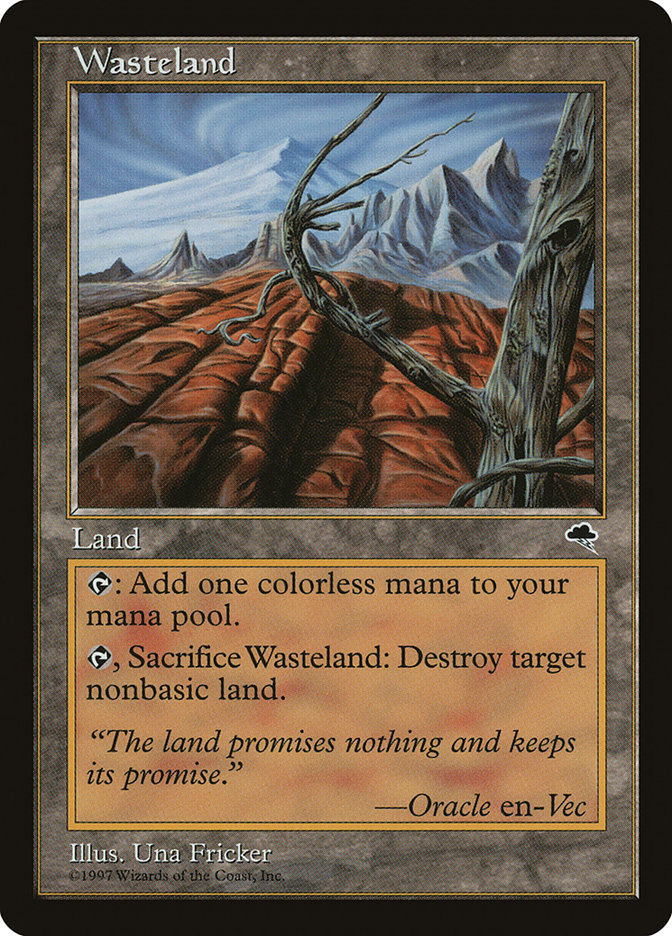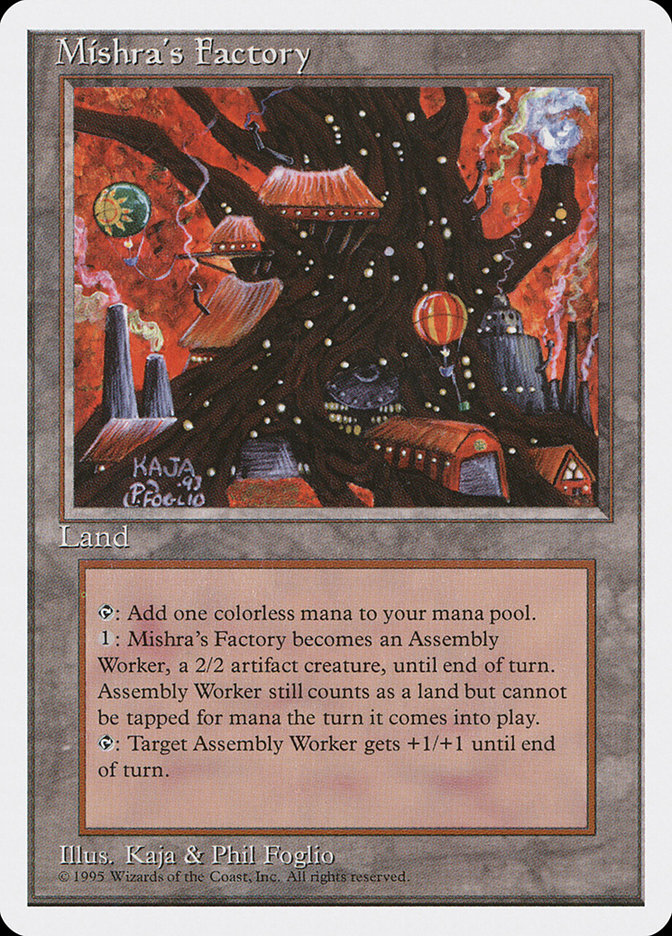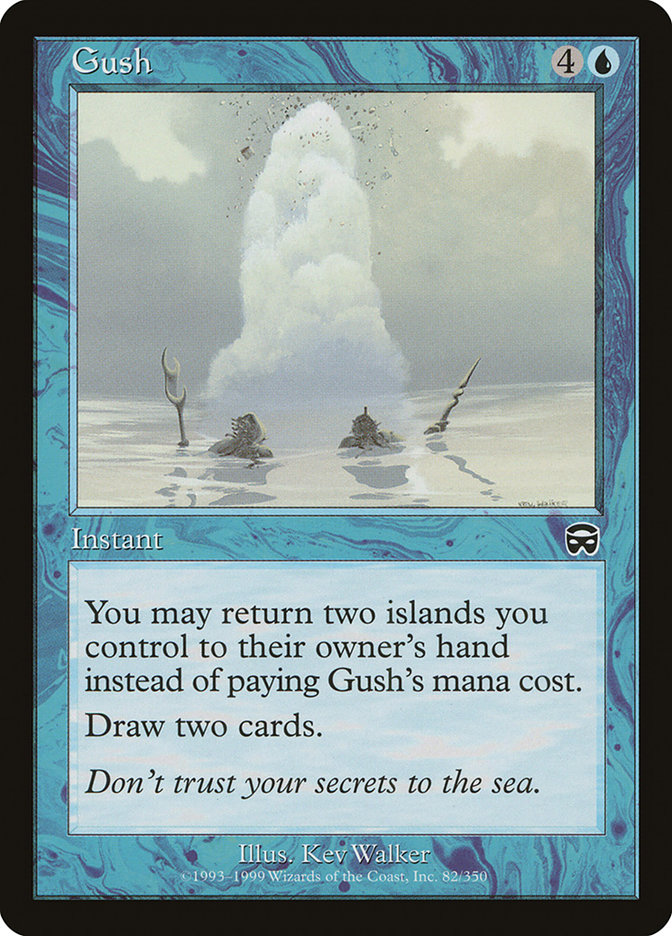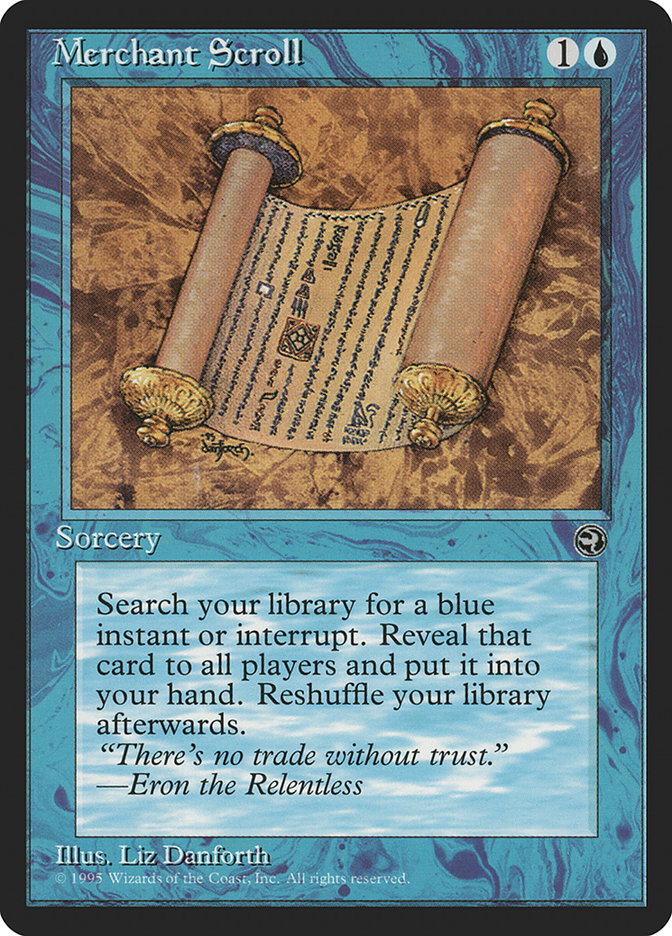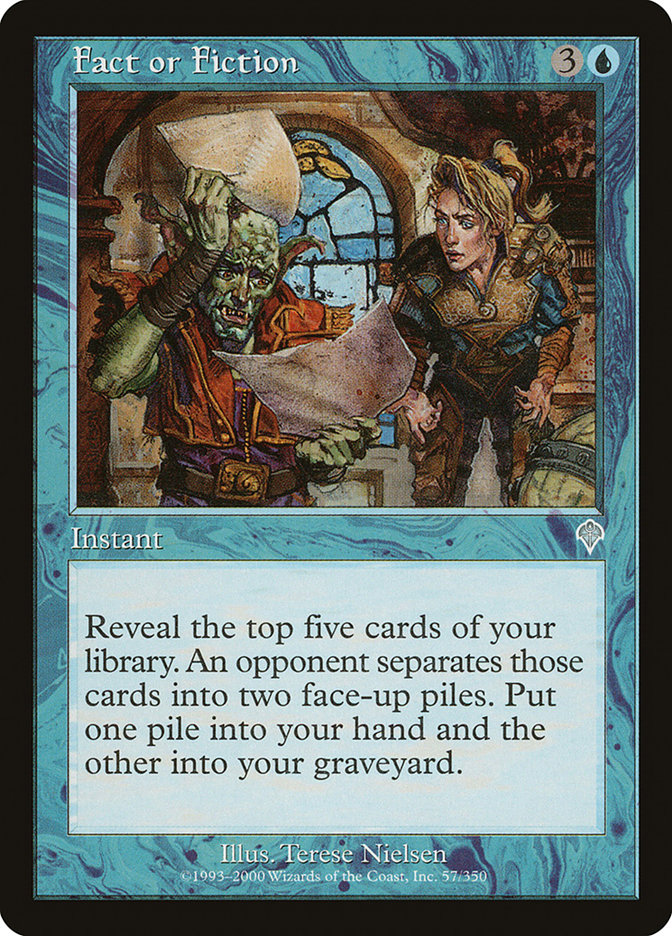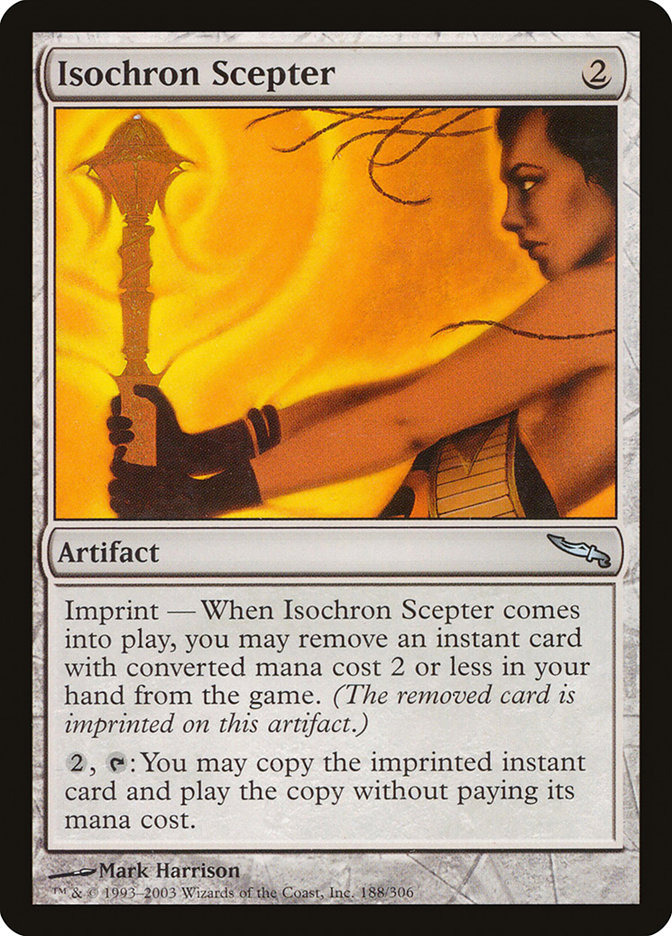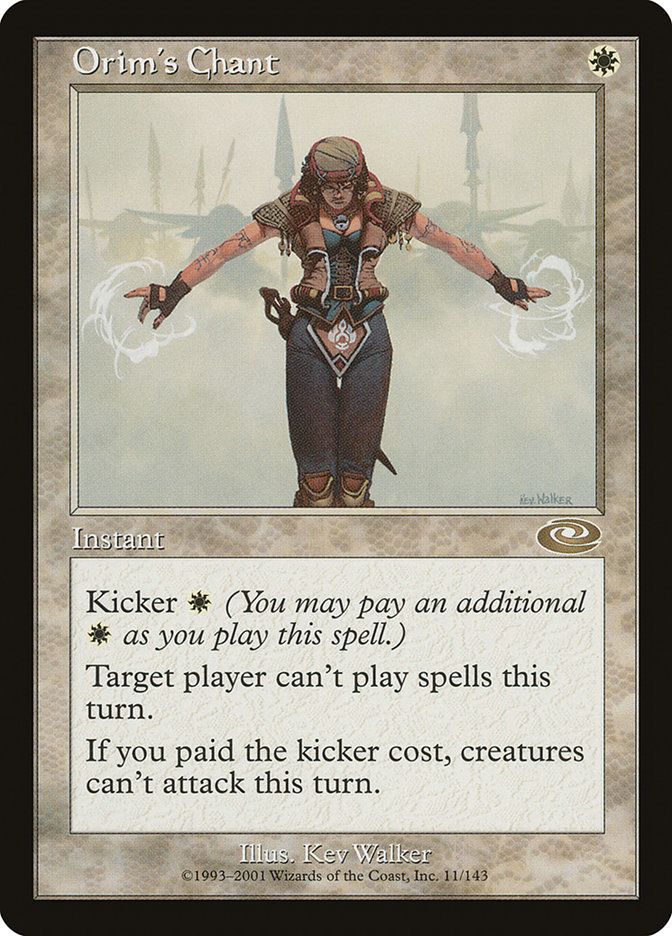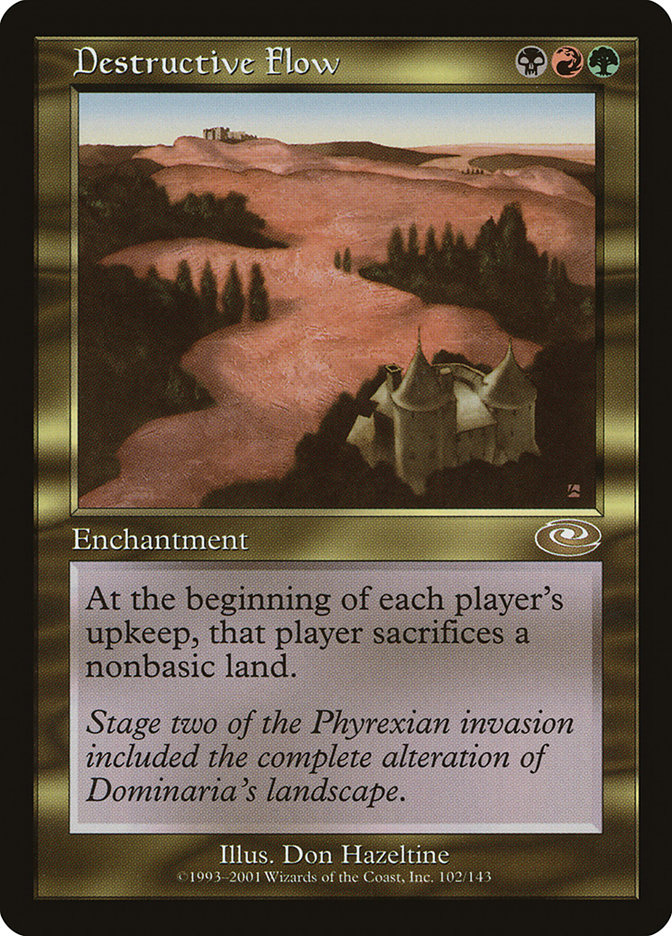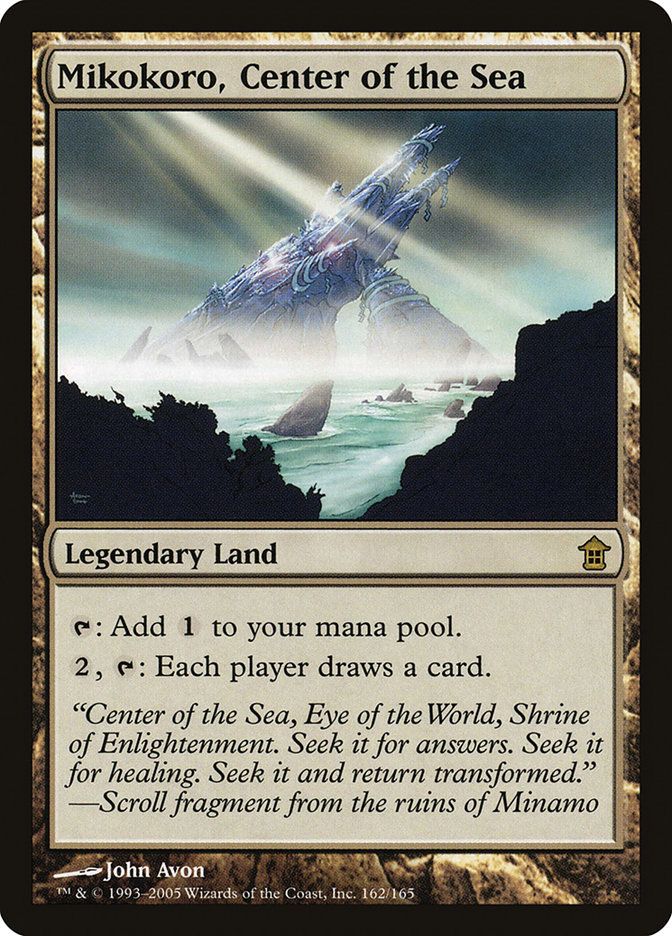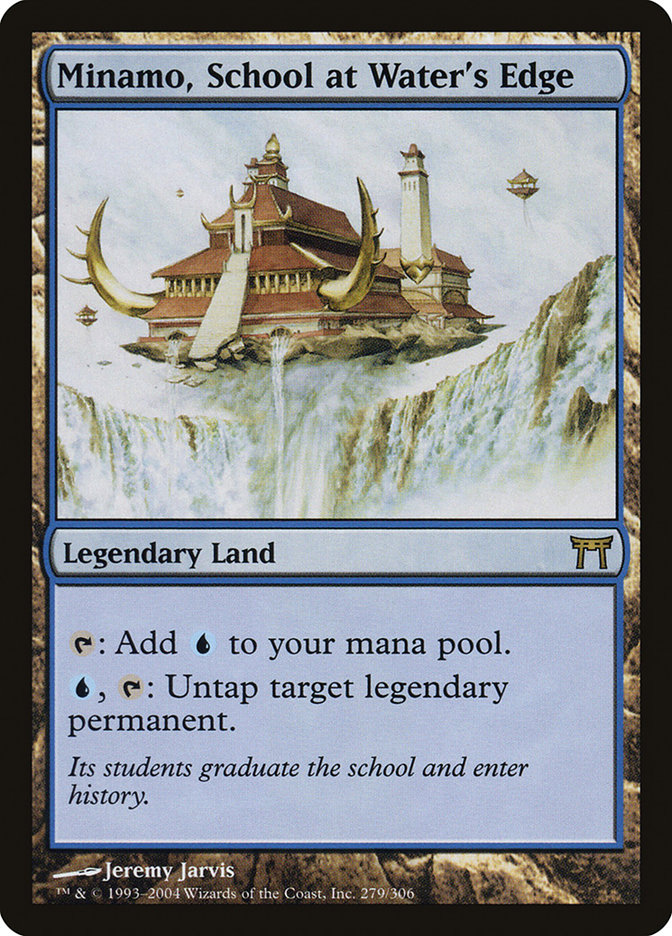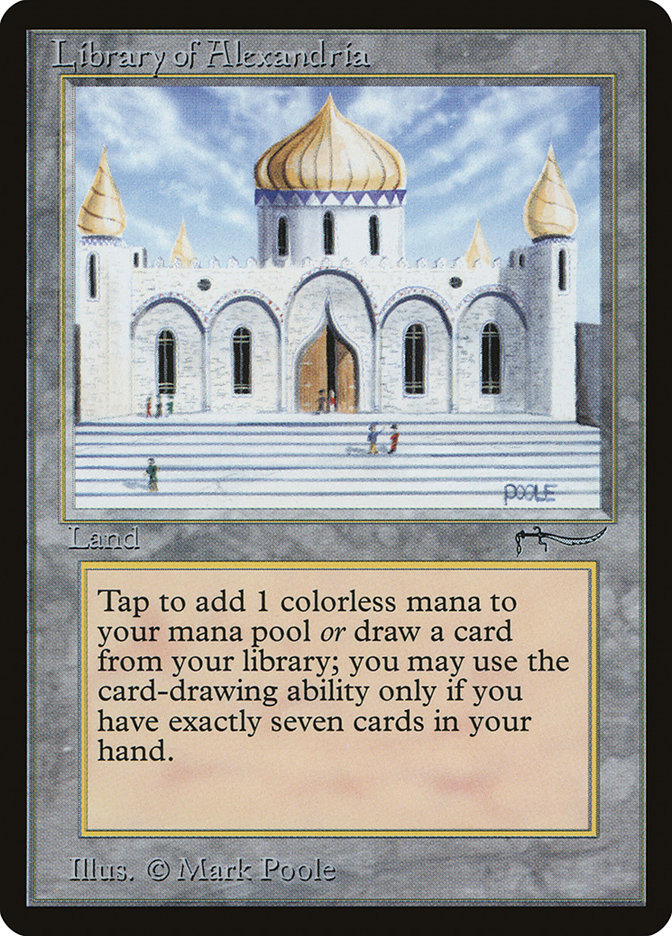Sometimes on a good day a person gets to experience the wonderful feeling of running extremely good at a Magic tournament. One of those magical afternoons where a player simply will not be denied victory, round after round slaying one opponent after another at the top tables.
I have been extremely fortunate during my many years of playing tournament Magic to have experienced a few days like these. One thing I know for certain about these special days is that every time my deck did the burden of the heavy lifting for me.
Sure, a player has to actually play reasonably well to go on a tear, but without a great deck to pilot, it is extremely difficult to go the distance.
In today’s article, I’m going to revisit the five best decks that I have ever had the privilege to pilot and explain what each of these decks taught me about the infinitely complex game of Magic: The Gathering.
5. U/W/R Landstill In Legacy
It was a day just like any other and then BAM! New Phyrexia happened.
These are going to be Legacy playable, right?
Grand Prix Providence 2011 was the first big Legacy tournament in which the incredibly powerful cards from New Phyrexia were tournament-legal.
Understatement of the century—they were good.
Creatures (5)
Planeswalkers (3)
Lands (22)
Spells (30)

It was 2011, and there were Merfolk, Goblins, and Zoo decks everywhere.
Then there were the people who figured out that Stoneforge Mystic + Batterskull + Mental Misstep was the absolute stone blade.
I would go on record as saying it was poor judgment not to play these cards at this event.
It’s not like a lot of people didn’t know it was insane because the concept was certainly a known commodity; however, despite it being a known commodity, there were a lot of people playing decks that were much worse than this strategy.
And what happens when a lot of people play decks that are worse than the best deck and you are playing the best deck?
You win a lot.
Another angle to attack.
What happens when you take two extremely powerful strategies that have synergy and put them together?
Reese’s Peanut Butter Cups.
Exactly—an absolutely insane deck that can attack people from a bunch of different angles.
The biggest thing I learned from this tournament was exactly how powerful combining two powerful strategies can really be. Think about it; many of the best decks of all time are a combination of two powerful strategies: Thopter Depths, Stoneblade Twin, Tinker + Yawgmoth’s Will, and on and on.
When I’m looking to build decks or looking for new angles to attack a metagame, I often fall back on this lesson and will look to combine two powerful strategies that already exist into one singular deck.
4. Gush Control In Vintage
Many of the newer players may not actually know this, but back before the Open Series StarCityGames.com now runs, the large traveling tournament circuit was Vintage!
I had made Top 8 of more than a half dozen of these tournaments, but I didn’t finally win one until the very last SCG Power 9 Tournament in 2008.
The previous day I had played Rich Shay Gush Oath deck without really playtesting the deck very much and absolutely hated everything about it. I couldn’t Gush because I had Orchard in play. I couldn’t Oath because I didn’t have Orchards.
It was an unpleasant day.
However, I did end up going 7-2 after a 1-2 start and got ninth place despite not really liking how the deck played. The things I knew for certain after the tournament were that I wanted to Gush the next day and that I wanted my Gush deck to be filled with super powerful spells.
Creatures (2)
Lands (16)
Spells (42)
- 1 Sensei's Divining Top
- 1 Tendrils of Agony
- 4 Brainstorm
- 1 Fastbond
- 2 Mana Drain
- 1 Vampiric Tutor
- 1 Mystical Tutor
- 1 Yawgmoth's Will
- 1 Duress
- 4 Force of Will
- 1 Demonic Tutor
- 1 Time Walk
- 1 Ancestral Recall
- 4 Gush
- 1 Mind's Desire
- 4 Merchant Scroll
- 1 High Tide
- 1 Chain of Vapor
- 1 Black Lotus
- 1 Lotus Petal
- 1 Mox Emerald
- 1 Mox Jet
- 1 Mox Ruby
- 1 Mox Sapphire
- 1 Empty the Warrens
- 4 Thoughtseize

First of all, this tournament was probably the best "run good" day of Magic I’ve ever had. I’m fairly certain I only lost one game of Magic the entire day, and that was in the finals to me calling a judge on myself after drawing a sideboard card in game 1 in the middle of going off.
Secondly, this deck is insanely powerful.
All four-ofs—ah, the good old days.
Lastly, this deck was super innovative.
It isn’t a Grow deck, as was the deck of the age, but rather a full-on dedicated Gush combo deck.
I had also never even seen a Gush deck that played Dark Confidant before this deck. When I was brewing it up with the other Meandeck guys at the hotel, I was repeatedly told I was crazy to play Dark Confidant in a deck that had eight 5CC spells.
Turns out that Gush and Bob are ok together.
You can’t put Bob in a Gush deck!
You see, I wanted to play Gush because I knew from playing with the card that it was simply better than everything else. However, I didn’t like the shells that other people had put the card into.
Oath? Ick. Oath + Gush is two combos (which I have already said is good), but the problem is that the Gush combo was simply so much more powerful than the Oath side.
Also, remember we didn’t have Griselbrand to Oath up, only Tidespout Tyrant.
I didn’t want to mess around with a mediocre soft combo in my busted deck and instead opted to replace my Oaths, Orchards, and Tyrants with cards that are actually busted and help me get to and protect my combo: Mana Drain, High Tide, Dark Confidant, etc.
I learned two important lessons from building and playing this deck.
First, one must always trust their own experiences and insights and not blindly listen to what other people say. Now, I’m not saying to disregard other people with experience who have something to offer and can help you, but if you play games with a deck and learn and understand what is going on, then you’ve got to trust what you know.
Secondly, I learned that when one has a good and broken thing going that there is no reason to bog it down with cutesy stuff that detracts from making the magic happen.
Why mess around with Dryads or Oath of Druids in a deck that basically wins on the spot as soon as it resolves a Fastbond?
I trusted my observations, was correct, and got paid off for it.
3. No Stick In Extended
What a trip down memory lane this decklist is.
Creatures (1)
Lands (23)
Spells (36)

I got to play control back when control really meant control.
No Stick earned me my first ever invite to the Pro Tour, so I will always have a pretty soft spot in my heart for this list.
I would like to think that I was a pretty good Magic player eight years ago in 2005, but in all likelihood I was probably not very good. No Stick got me there.
The deck is full of extremely powerful cards: Counterspell, Fact or Fiction, Lightning Helix, Fact or Fiction, Wrath of God, Fact or Fiction, Isochron Scepter + Orim’s Chant, and did I mention:
This used to be a card people could play with in Extended. It was pretty fair.
The deck basically crushed most of the field outright and had the "I win" combo of Scepter + Orim’s Chant that actually locked out many decks.
Hey, I won!
Many decks actually just conceded on the spot to this combo on the first or second turn, which was a good reason to be playing the deck.
The key to this list that actually allowed me to win the tournament was that I was able to solve two problems: 1) destructive flow and 2) the mirror.
How can we beat this popular card?
Duh. I’m a genius—I added basic lands and problem solved.
The second problem was much trickier, and I was lucky that a young Kenta Hiroki (now resident Michigan control mastermind) shared some very impressive technology with me.
Mirror-breaking technology.
The mirror match usually came down to land drops, card advantage, and resolving key spells like Cunning Wish. Also, the games almost always went long, and whoever won game 1 usually took the match. So Kenta figured out that if you get Mikokoro into play and make both players (who usually have seven cards in hand at all times) draw a card on the opponent’s end step, the opponent would have to discard.
Then the hero could untap and play a land and pass. Then a player adds Minamo to the equation to double the damage.
Build your own . . .
The opponent would be unable to keep up with land drops and eventually lose. It was a pretty huge breakthrough that helped me easily win the No Stick mirror match three times that day.
The biggest thing I learned from my No Stick deck was that when you have a deck that crushes a bunch of decks outright, the key to actually winning a tournament becomes careful tuning for the other, peskier matchups.
In this case, refining my mana base and getting some clever technology to break the mirror allowed me to run the table!
2. Naya Land Destruction In Modern
Hey! A nonblue deck.
Actually, for this Pro Tour (basically the first Modern event EVER), I vowed off playing blue decks altogether. What’s more fun than a blue deck? A land destruction deck!
I had a lot of help on this deck from Ari Lax, Michael Jacob, Drew Levin, and Matt Sperling, and it turned out quite nicely. In fact, everybody who played the deck at the Pro Tour finished in the money.
Creatures (18)
- 1 Birds of Paradise
- 4 Kavu Predator
- 3 Tarmogoyf
- 1 Gaddock Teeg
- 4 Noble Hierarch
- 4 Knight of the Reliquary
- 1 Qasali Pridemage
Lands (24)
Spells (18)

The obvious decks to beat at this tournament were Cloudpost and Zoo, and I figured that big Naya LD was a pretty good place to start.
The deck looks like absolute craziness, and I for sure got my share of raised eyebrows as I played out my Kavu Predators round after round!
I was on the Kavu plan.
Kavu Predator was a card that way back in the day when I was drafting and cracking packs of Planar Chaos that I remember thinking "this card is so cool—I really hope I get to make a deck around it one day!"
Which is why it randomly came to mind when I was thinking about ways to attack Zoo decks. What if, I thought, I made a deck with Oust, Punishing Fire, Grove of the Burnwillows, Fiery Justice, and Kavu Predator?
Just make the Kavu Predator an absolute all-star in the deck mentality.
It actually turned out that Kavu Predator was insane against Cloudpost decks because their big plan to stabilize was to Glimmerpost and gain a bunch of life and Kavu Predator basically negates that plan altogether and becomes a Sulfuric Vortex!
There were also those fun games where I got to open up with Noble Hierarch and then on my second turn play Kavu Predator and Oust their Wild Nacatl. Yeah, 5/5 trampler.
My Naya deck taught me two important lessons.
First, when the metagame appears to be two very popular decks, figuring out a strategy that is good against both goes a long, long way!
Secondly, when you are brewing decks (especially for new or unexplored formats), think back about cards that you have always thought were good but never had a home before. If you see a card and you think it is good but it doesn’t have a home yet, chances are at some point that card will find a place to shine!
1. Burning Slaver In Vintage
My favorite deck of all time and probably the deck that I have played the most is Control Slaver.
I probably played some iteration of this deck in over 50 Vintage tournaments and knew the deck inside and out.
First of all, the deck was extremely powerful for its time and was basically just the best deck in the format on and off for the better part of four years. Secondly, the deck really rewarded smart play (every deck does, but this one especially) and even more so rewarded good choices with regard to tuning the deck.
Creatures (6)
Lands (16)
Spells (38)
- 4 Brainstorm
- 4 Mana Drain
- 1 Mystical Tutor
- 1 Yawgmoth's Will
- 4 Force of Will
- 1 Mana Vault
- 1 Sol Ring
- 1 Demonic Tutor
- 1 Time Walk
- 1 Ancestral Recall
- 1 Mana Crypt
- 1 Gifts Ungiven
- 1 Burning Wish
- 1 Merchant Scroll
- 1 Crucible of Worlds
- 4 Thirst for Knowledge
- 1 Mindslaver
- 1 Echoing Truth
- 1 Tinker
- 1 Black Lotus
- 1 Recoup
- 1 Mox Emerald
- 1 Mox Jet
- 1 Mox Pearl
- 1 Mox Ruby
- 1 Mox Sapphire

The first important lesson I learned from Control Slaver came before I had ever even played a game with the deck. Mark Biller had the deck together, and I quickly discovered that the succinct, quick combo kills of Sundering Titan (Armageddon you) or Mindslaver were simply much more efficient ways to end games of Vintage than trying to control the game for four more turns while attacking with a Morphling!
It didn’t take long before I was completely on board with playing a combo control deck in Vintage instead of the outdated pure control models.
Being able to win quickly and efficiently is so important in modern Magic rather than simply durdling around with small advantages and giving the opponent opportunities to fight back into the game.
The second thing I learned from playing Slaver was that if you practice and get really good at piloting a deck, you can adapt it and tune it to perform well even as a metagame shifts.
If the deck is truly a tier 1 deck, it can be tuned to take on all comers as the metagame shifts between being aggro-heavy, control-heavy, combo-heavy, or whatever the occasion may call for.
I also learned the advantages of playing decks that are flexible in the ways that they are able to play games. Control Slaver could combo out on the first or second turn with the nuts, but it could also fight wars of attrition over basically any resource that was important.
A good control deck, or combo control deck, has to generate card advantage but also be able to flip the script, take over, and win the game quickly and efficiently.
The cool thing about great decks is that once you play one you learn to look for similar qualities in other decks. The more great decks that a player gets the opportunity to play over time, the better that player becomes at identifying and building good decks in the future. I hope that you all enjoyed my little stroll down memory lane and can take away from it some of the lessons I’ve learned about good deckbuilding and selection.
Thanks for reading.
Cheers,
Follow me @Briandemars1 on Twitter

